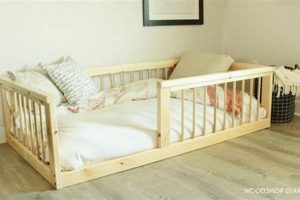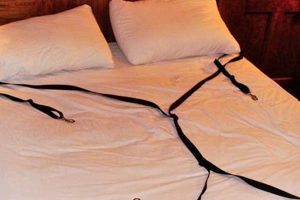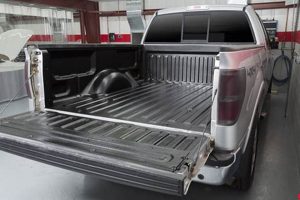The creation of a convertible sofa that transitions into a sleeping surface, achieved through do-it-yourself methods, constitutes a specific subset of furniture construction. Such projects often involve repurposing existing couches or building a new frame designed for dual functionality. An example includes modifying a standard three-seater sofa by adding a hinged section and supporting legs to create a flat sleeping area when unfolded.
Engaging in such construction offers various advantages, including cost savings relative to purchasing commercially manufactured convertible sofas, customization options tailored to specific spatial requirements and aesthetic preferences, and the satisfaction of completing a functional project. Historically, individuals have adapted furniture for space optimization, and this practice continues to evolve with readily available online resources and adaptable designs.
The subsequent discussion will examine various techniques and considerations for designing and implementing this type of project, including frame construction methods, material selection criteria, and mechanisms for seamless conversion between seating and sleeping configurations. These areas represent critical components in achieving a successful and durable outcome.
Essential Guidelines for Convertible Sofa Construction
The following points highlight critical considerations for individuals undertaking the construction of a convertible sofa. Adherence to these guidelines can significantly impact the project’s success and the resulting furniture’s longevity.
Tip 1: Frame Stability is Paramount. Prioritize the use of durable materials, such as hardwood or reinforced steel, for the structural framework. Weak frame construction can lead to instability and eventual failure of the conversion mechanism.
Tip 2: Mechanism Selection Influences Functionality. Carefully evaluate available conversion mechanisms based on desired ease of use, weight capacity, and spatial limitations. Options range from simple fold-out designs to more complex pull-out or click-clack mechanisms.
Tip 3: Accurate Measurements are Indispensable. Meticulously measure all dimensions before cutting materials. Discrepancies can result in misaligned components and a non-functional final product.
Tip 4: Upholstery Fabric Affects Aesthetics and Durability. Choose upholstery fabric that is both aesthetically pleasing and resistant to wear and tear. Consider factors such as stain resistance, abrasion resistance, and ease of cleaning.
Tip 5: Cushion Density Impacts Comfort. Select foam or batting with appropriate density for both seating and sleeping comfort. Overly soft cushions may lack support, while excessively firm cushions may be uncomfortable for extended use.
Tip 6: Hardware Selection Merits Attention. Utilize high-quality hinges, screws, and other hardware to ensure reliable performance of the conversion mechanism. Inferior hardware is prone to breakage and can compromise the overall stability.
Tip 7: Safety Considerations are Crucial. Incorporate safety features, such as locking mechanisms to prevent accidental collapse and smooth edges to minimize the risk of injury. Thoroughly test the completed structure before regular use.
Effective implementation of these guidelines contributes to a structurally sound, aesthetically pleasing, and functionally reliable convertible sofa.
The subsequent section will address common challenges encountered during such construction projects and provide potential solutions to mitigate these issues.
1. Frame's Structural Integrity
Frame’s structural integrity serves as the foundational cornerstone of any successful convertible sofa construction. In the context of undertaking such a do-it-yourself project, the frame dictates the overall stability, weight-bearing capacity, and long-term durability of the final product. Inadequate frame construction directly precipitates a cascade of negative consequences, ranging from premature wear and tear to potential structural failure under normal usage. This is due to the repeated stress of converting between seating and sleeping configurations and the added weight distribution when used as a bed.
The choice of materials profoundly influences frame integrity. For instance, using untreated softwood lumber may initially appear cost-effective, but it lacks the inherent strength and resistance to warping necessary to withstand sustained stress. Conversely, employing kiln-dried hardwood or reinforced metal framing offers superior resistance to deformation and extends the lifespan of the furniture. The joinery methods utilized are equally critical. Simple butt joints secured with screws provide minimal resistance to shear forces, whereas mortise-and-tenon joints or metal brackets create significantly stronger connections. Consider a scenario where an individual constructs a frame using flimsy materials and weak joinery; the resulting convertible sofa is likely to exhibit excessive sagging, instability, and eventual breakage under normal use.
Ultimately, the investment in robust frame materials and sound construction techniques directly correlates with the longevity and safe functionality of the convertible sofa. Neglecting this fundamental aspect undermines the entire project, rendering the time and resources expended largely futile. Prioritizing the frame’s structural integrity is, therefore, not merely a technical consideration but an essential prerequisite for creating a durable and practical piece of furniture. Ignoring this element often leads to higher costs in the long run, and potential safety hazards.
2. Mechanism Operational Reliability
Mechanism operational reliability constitutes a central determinant of success in convertible sofa construction. Within the realm of do-it-yourself projects, the chosen mechanism dictates the ease, smoothness, and consistency with which the sofa transitions between seating and sleeping configurations. An unreliable mechanism negates the practical benefits of a convertible design, rendering the furniture cumbersome and frustrating to use. This unreliability often stems from inadequate design, inferior materials, or imprecise assembly. A real-life example involves a fold-out mechanism employing weak hinges; repeated use causes the hinges to bend or break, ultimately preventing the sofa from fully extending into a bed or retracting into a seating position.
Furthermore, the impact of mechanism reliability extends beyond simple functionality to encompass safety considerations. A poorly designed or constructed mechanism may exhibit instability when deployed as a bed, posing a risk of collapse or injury to the user. Similarly, a mechanism that binds or requires excessive force to operate can lead to accidental pinches or strains. Therefore, selecting a robust mechanism and adhering meticulously to assembly instructions are critical steps in mitigating these risks. Practical application involves thoroughly researching available mechanisms, carefully evaluating their load-bearing capacity and ease of operation, and conducting rigorous testing of the assembled structure before regular use.
In summary, ensuring mechanism operational reliability is not merely a desirable feature but a fundamental requirement for creating a functional and safe convertible sofa. Overlooking this aspect undermines the core purpose of the design, transforming a potentially versatile piece of furniture into an impractical and potentially hazardous item. Attention to detail during mechanism selection, assembly, and testing is paramount for a successful and durable convertible sofa outcome.
3. Material Cost-Effectiveness
In the context of convertible sofa construction, the careful consideration of material cost-effectiveness is paramount, shaping the feasibility, accessibility, and overall value proposition of such projects. Balancing budgetary constraints with the need for durable and aesthetically pleasing materials necessitates strategic decision-making throughout the construction process.
- Source Material Selection
The choice between new materials and repurposed or reclaimed resources profoundly impacts overall costs. Opting for salvaged lumber or repurposed metal frames can substantially reduce expenses. However, sourcing reclaimed materials requires careful inspection for structural integrity and potential hazards, ensuring that cost savings do not compromise safety or longevity. A damaged source materials must be replaced resulting in higher cost.
- Bulk Purchasing versus Incremental Acquisition
Purchasing materials in bulk often yields significant discounts compared to acquiring them piecemeal. This strategy is particularly advantageous for common components like lumber, fasteners, and upholstery fabric. However, bulk purchasing necessitates accurate estimation of material requirements to avoid overspending on surplus items. For example buying too many fabric means paying storage fees.
- Material Substitutions and Alternatives
Exploring alternative materials with similar properties can provide opportunities for cost reduction. For instance, substituting solid hardwood with plywood for certain structural components, or using less expensive upholstery fabrics, can significantly lower the overall budget. The key lies in identifying suitable substitutes without sacrificing essential performance characteristics.
- Minimizing Material Waste
Efficient material usage directly translates to cost savings. Careful planning, precise cutting techniques, and the implementation of strategies to repurpose offcuts minimize waste and reduce the need for additional material purchases. Thorough planning and careful use of materials means lower project costs.
Integrating a cost-conscious approach to material selection allows individuals to successfully undertake the construction of convertible sofas within reasonable budgetary parameters. This strategic emphasis on cost-effectiveness expands the accessibility of this type of project, enabling a wider range of individuals to create customized and functional furniture solutions tailored to their specific needs and preferences. It also encourages creativity and resourcefulness in sourcing and utilizing materials.
4. Space Optimization Achieved
The concept of “Space Optimization Achieved” is intrinsically linked to the creation of convertible sofas. It represents a primary driver for undertaking such projects, as these designs inherently address the challenge of maximizing functionality within limited spatial environments. These sofa designs offer dual purpose and the ability to convert between seating and sleeping arrangements, making them a pivotal strategy in homes and rooms with square footage limitations.
- Multifunctional Furniture Integration
A convertible sofa exemplifies the concept of multifunctional furniture, serving as both a seating area during the day and a sleeping surface at night. This integration of two distinct functions into a single piece of furniture drastically reduces the need for separate, dedicated items, freeing up valuable floor space. An individual living in a small studio apartment might choose a convertible sofa to avoid the need for both a traditional sofa and a separate bed, thereby optimizing the limited square footage.
- Adaptable Room Layouts
These sofas facilitate the creation of adaptable room layouts that can be easily reconfigured to suit varying needs. A living room can quickly transform into a guest room by simply converting the sofa into a bed. This flexibility is particularly beneficial in homes that lack dedicated guest rooms, allowing for the efficient utilization of existing space. A host is easily able to provide a sleeping area for guests.
- Vertical Space Utilization
While often focused on horizontal space savings, convertible sofas can also contribute to vertical space utilization through integrated storage compartments. Some designs incorporate hidden storage beneath the seating area, providing a convenient location for storing bedding, pillows, or other items. This vertical integration further enhances the space-saving benefits of the furniture.
- Minimalist Design Promotion
The adoption of convertible sofas often aligns with a minimalist design philosophy, where the emphasis is on maximizing functionality with a minimal number of possessions. By consolidating seating and sleeping functions into a single item, individuals can reduce clutter and create a more open and spacious living environment. Fewer items results in less items, resulting in a more minimalist style of design.
These facets underscore how convertible sofa construction inherently contributes to “Space Optimization Achieved.” By integrating multiple functions, enabling adaptable layouts, facilitating vertical storage, and promoting minimalist design principles, these projects offer practical solutions for maximizing functionality within limited spatial environments, allowing for a more efficient and comfortable living experience.
5. User Skill Required
The successful execution of a convertible sofa construction project is intrinsically linked to the skill level of the individual undertaking the task. This connection between “User Skill Required” and the feasibility of completing a “couch bed diy” endeavor is fundamental, directly influencing the quality, functionality, and safety of the final product. Insufficient proficiency in relevant skills can lead to structural instability, mechanical malfunction, and compromised aesthetic appeal. For instance, an individual lacking competence in woodworking may struggle to accurately cut and join frame components, resulting in a weakened structure prone to collapse. Similarly, inadequate upholstery skills can lead to uneven fabric tension, unsightly wrinkles, and premature wear of the upholstery material. Therefore, an accurate self-assessment of existing capabilities constitutes a critical initial step in determining project suitability.
Several specific skill sets directly contribute to project success. Proficiency in woodworking techniques, including accurate measuring, cutting, joining, and finishing, is essential for frame construction. Upholstery skills, such as fabric cutting, sewing, and applying batting, are necessary for creating comfortable and aesthetically pleasing cushions and covers. Familiarity with basic mechanical principles is required for assembling and adjusting the conversion mechanism. Moreover, a basic understanding of structural engineering principles is beneficial for ensuring the stability and load-bearing capacity of the final product. Consider the example of someone attempting to install a complex pull-out mechanism without understanding its operational requirements; the resulting convertible sofa may be difficult or impossible to convert between seating and sleeping positions. Practical application involves investing time in acquiring necessary skills through online tutorials, workshops, or mentorship from experienced craftspeople. The absence of these vital skills could lead to costly mistakes and an unusable final product.
In summary, the relationship between user skill and the viability of a convertible sofa project is direct and consequential. Adequate proficiency in woodworking, upholstery, mechanics, and structural principles is essential for achieving a successful and durable outcome. Individuals contemplating such projects should honestly assess their existing skill sets and dedicate time to acquiring necessary knowledge and experience before commencing construction. This proactive approach minimizes the risk of errors, enhances the quality of the final product, and ensures a satisfying and functional addition to the living space. It is paramount to approach this type of project with a realistic assessment of one’s skills to avoid costly mistakes and ensure a positive and safe outcome.
Frequently Asked Questions
This section addresses common inquiries regarding the design, construction, and maintenance of convertible sofas created through do-it-yourself methods. The information presented aims to provide clarity and guidance for individuals considering such projects.
Question 1: What is the estimated timeframe for constructing a convertible sofa?
The timeframe varies considerably based on the complexity of the design, the skill level of the constructor, and the availability of tools and materials. A basic fold-out design may be completed within a weekend, while more intricate pull-out mechanisms and custom upholstery could require several weeks.
Question 2: What tools are essential for convertible sofa construction?
Essential tools typically include a circular saw or table saw for cutting lumber, a drill and driver for assembling the frame, a measuring tape and level for ensuring accuracy, a sewing machine for upholstery, and various hand tools such as a hammer, screwdrivers, and pliers.
Question 3: How does one determine the appropriate dimensions for a convertible sofa frame?
Frame dimensions are determined by considering the desired size of the sofa in both seating and sleeping configurations. The frame must be large enough to comfortably accommodate users in both modes, while also fitting within the intended space in the room. Careful measurements and planning are crucial.
Question 4: What types of wood are best suited for constructing a convertible sofa frame?
Hardwoods such as oak, maple, and birch are generally preferred for their strength and durability. Softwoods such as pine may be used for less critical components, but should be avoided for load-bearing elements.
Question 5: How should the weight capacity of a convertible sofa be determined?
The weight capacity should be determined based on the intended use of the sofa, considering the number of people who may be seated or sleeping on it simultaneously. The frame and mechanism should be designed to withstand this maximum load with a safety factor of at least 2.
Question 6: What maintenance is required to ensure the longevity of a convertible sofa?
Regular maintenance includes cleaning upholstery to prevent staining, tightening loose fasteners, lubricating moving parts of the mechanism, and inspecting the frame for signs of damage or wear. Prompt attention to these issues can significantly extend the lifespan of the furniture.
In summary, convertible sofa construction presents a rewarding but demanding undertaking. A meticulous approach to planning, material selection, and construction techniques is vital for achieving a durable and functional piece of furniture.
The subsequent section will explore advanced design considerations and customization options for experienced constructors.
Conclusion
The preceding examination of “couch bed diy” has elucidated the multifaceted nature of such projects. It encompasses considerations ranging from structural integrity and mechanism reliability to material cost-effectiveness, space optimization, and the requisite user skill set. Each element plays a crucial role in determining the feasibility and ultimate success of constructing a functional and durable convertible sofa.
Careful evaluation of these factors, coupled with meticulous planning and execution, is essential for achieving a satisfactory outcome. The potential benefits, including cost savings, customization options, and space efficiency, warrant serious consideration. Prospective constructors are encouraged to engage in thorough research and acquire the necessary skills before embarking on this complex endeavor. The long-term value and practicality of a well-executed convertible sofa underscores its significance in optimizing living spaces and accommodating diverse needs.







